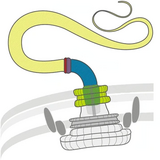| Part of a series on |
| Microbial and microbot movement |
|---|
 |
| Microswimmers |
| Molecular motors |
Bacterial motility is the ability of bacteria to move independently using metabolic energy. Most motility mechanisms that evolved among bacteria also evolved in parallel among the archaea. Most rod-shaped bacteria can move using their own power, which allows colonization of new environments and discovery of new resources for survival. Bacterial movement depends not only on the characteristics of the medium, but also on the use of different appendages to propel. Swarming and swimming movements are both powered by rotating flagella. Whereas swarming is a multicellular 2D movement over a surface and requires the presence of surfactants, swimming is movement of individual cells in liquid environments.
Other types of movement occurring on solid surfaces include twitching, gliding and sliding, which are all independent of flagella. Twitching depends on the extension, attachment to a surface, and retraction of type IV pili which pull the cell forwards in a manner similar to the action of a grappling hook, providing energy to move the cell forward. Gliding uses different motor complexes, such as the focal adhesion complexes of Myxococcus. Unlike twitching and gliding motilities, which are active movements where the motive force is generated by the individual cell, sliding is a passive movement. It relies on the motive force generated by the cell community due to the expansive forces caused by cell growth within the colony in the presence of surfactants, which reduce the friction between the cells and the surface. The overall movement of a bacterium can be the result of alternating tumble and swim phases. As a result, the trajectory of a bacterium swimming in a uniform environment will form a random walk with relatively straight swims interrupted by random tumbles that reorient the bacterium.
Bacteria can also exhibit taxis, which is the ability to move towards or away from stimuli in their environment. In chemotaxis the overall motion of bacteria responds to the presence of chemical gradients. In phototaxis bacteria can move towards or away from light. This can be particularly useful for cyanobacteria, which use light for photosynthesis. Likewise, magnetotactic bacteria align their movement with the Earth's magnetic field. Some bacteria have escape reactions allowing them to back away from stimuli that might harm or kill. This is fundamentally different from navigation or exploration, since response times must be rapid. Escape reactions are achieved by action potential-like phenomena, and have been observed in biofilms as well as in single cells such as cable bacteria.
Currently there is interest in developing biohybrid microswimmers, microscopic swimmers which are part biological and part engineered by humans, such as swimming bacteria modified to carry cargo.
